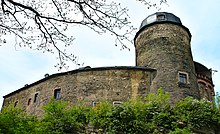Mylau Castle
| Mylau Castle | |
|---|---|
| Burg Mylau | |
| Mylau | |

Mylau Castle
|
|
| Coordinates | 50°37′06″N 12°15′56″E / 50.618264°N 12.265469°ECoordinates: 50°37′06″N 12°15′56″E / 50.618264°N 12.265469°E |
| Type | Hill castle, Spornburg |
| Code | DE-SN |
| Site information | |
| Condition | Mainly preserved |
| Site history | |
| Built | circa 1180 |
| Garrison information | |
| Occupants | Emperor, Fürst, Nobility |
Mylau Castle (formerly also known as Imperial Castle Mylau) is a fortification on a spur in Mylau, Vogtland, Saxony, Germany. It is one of the best-preserved medieval castles in Saxony.
The castle was probably erected during the German eastward expansion under the regime of Emperor Barbarossa. It offered protection to the predominantly Frankish settlers in an area that was sparsely inhabited by Slavs. Under the protection of the castle, among others the trade city Reichenbach im Vogtland was founded. The 27 m (89 ft) tall Bergfried was built according to Romanesque style. The castle was built as hill castle with a single courtyard on a ridge of approximately 80 m (262 ft) long and 35 m (115 ft) wide, at the point where the Seifenbach flows into the Göltzsch river. Originally four defense towers and a 10 m (33 ft) deep dry moat surrounded the castle.
The first record of the Lords of Milin who inhabited the castle dates from 1214. As a result of the War of Vogtland (1354–1357), emperor Charles IV ordered them in 1367 to sell the castle to the Bohemic crown. That same year, he visited the castle and granted town privileges to the adjacent town of Mylau. Charles IV, whose relief in porphyry can be seen above the main entrance gate, instated a royal Bohemian office and began the expansion of the structure, which was continued by his sons Wenceslaus IV and Sigismund. Part of the castle was destroyed in 1400 due to a feud between Wenceslaus IV and the Vögte of the Vogtland. During the renovations, two large outer baileys were erected.
...
Wikipedia

